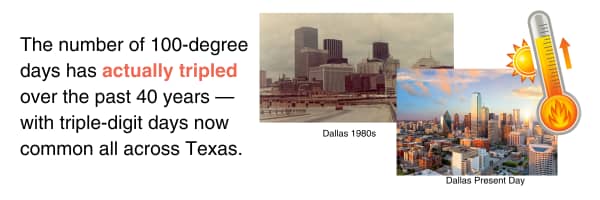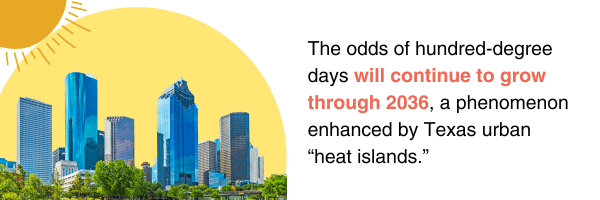Sneak peek: Our extreme weather report gets an update
This is a preview of our Texas 2036 newsletter with a sneak peek at the soon-to-be-released update to our extreme weather trends report. To receive this weekly look at our work, sign up here.
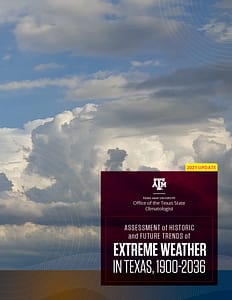 Our joint report on trends in extreme weather in Texas released with Texas State Climatologist John Nielsen-Gammon and Texas A&M University has become the go-to guide for those looking to understand climate trends out to 2036, the year of our bicentennial.
Our joint report on trends in extreme weather in Texas released with Texas State Climatologist John Nielsen-Gammon and Texas A&M University has become the go-to guide for those looking to understand climate trends out to 2036, the year of our bicentennial.
In just the last few months, the report was cited by sources as diverse as the editorial board of the Dallas Morning News and the Federal Reserve Bank of Dallas.
Since the release of the extreme weather report in 2021, Texas has continued to experience more instances of extreme weather events, notably with the drought and heat of the summer of 2023. Ahead of the report’s next comprehensive update early next year, we present some new findings on extreme temperatures that will be included in the update.
And ahead of the update’s release, you can view that first look here.
What the climate report will say about extreme heat
Following a relatively mild summer in 2021, the heat came back with a vengeance. The number of triple-digit days was above average in 2022 and hit record-setting territory in 2023. As a result of this, the long-term trend in the number of triple-digit days is sharply upward.
What the climate report will say about flash droughts
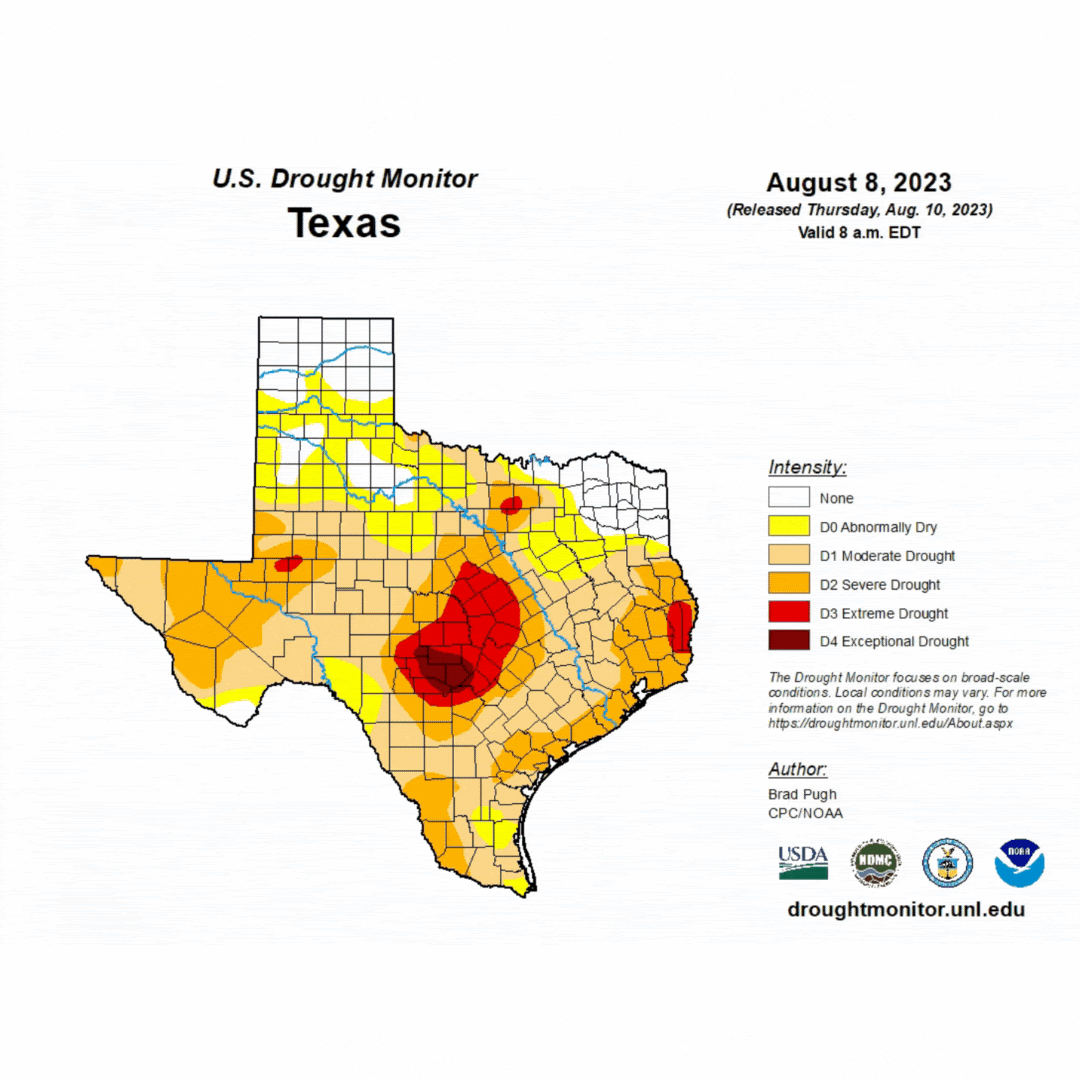 “What the state experienced in the summer of 2023 is the sort of drought we can expect more often in the future.”
“What the state experienced in the summer of 2023 is the sort of drought we can expect more often in the future.”
– Dr. John Nielsen-Gammon, Texas State Climatologist
The historical trend toward warmer temperatures is becoming easier and easier to detect. Milder winters are being offset by increasingly hot summers.
The flash drought of 2023 fit this pattern, as the excess heat increased evaporation and allowed drought impacts to develop more rapidly.
Keeping it 💯
No matter where you live in Texas, this summer was brutal. Here’s a list of the Top 5 most populous metro areas in Texas ranked by the number of 100 degree days recorded in 2023.
☀️ Austin: 80 days
☀️ San Antonio: 75 days
☀️ El Paso: 70 days
☀️ Dallas/Fort Worth: 55 days
☀️ Houston: 45 days
🥵 San Antonio was downright sweltering… the Alamo City didn’t just set a new record for 100 degree days this year, it smashed the old record. The 75 days above 100 degrees this year was 16 days more than the previous record from 2009.
Both San Antonio and El Paso set records for the most 100 degree days recorded in a single year while Austin and Houston recorded the second most 100 degree days.
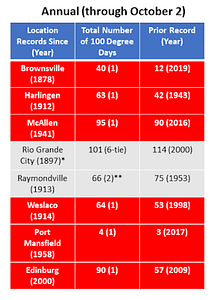 Residents of the southmost areas of the state in the Rio Grande Valley are used to hot weather. But they also endured record-setting heat this summer.
Residents of the southmost areas of the state in the Rio Grande Valley are used to hot weather. But they also endured record-setting heat this summer.
Six cities (see NWS Brownsville’s chart) set records for total number of 100 degree days. McAllen ended up with a couple more days of 100 degree weather after this chart was made — making for 97 days above 100 degrees this year!
Here’s what the update to our report has to say about this statewide trend toward more 100 degree days:
In almost all regions of the state, it’s now common to have at least 10 triple-digit days in a given year, while in the 1970s and 1980s such an occurrence was rare.
In coastal regions, a summer with multiple triple-digit days has gone from rare to ordinary, and a typical station in south-central Texas can now expect to see multiple weeks’ worth of triple-digit days in the summertime.
Higher home insurance rates — another result of extreme weather
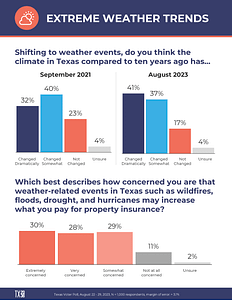 According to an article this fall in the Texas Tribune, property insurance rates have increased 22% on average this year, attributable in apart to 16 $1 billion disasters in Texas this year — the most ever recorded in a single year.
According to an article this fall in the Texas Tribune, property insurance rates have increased 22% on average this year, attributable in apart to 16 $1 billion disasters in Texas this year — the most ever recorded in a single year.
Our most recent Texas Voter Poll demonstrated that voters are already drawing the connection between increased frequency of extreme weather events and what they’re paying for homeowner’s insurance.
The poll showed that 78% of Texas voters recognize Texas’ climate has changed over the past 10 years, with 41% of respondents saying those changes have been dramatic. And 87% of voters said they were concerned weather-related events in Texas such as wildfires, floods, drought and hurricanes could increase what they pay for property insurance.
Taking steps to future-proof Texas
 Investments in the building blocks of the 21st century, such as our increasingly vulnerable water infrastructure, could help the state future-proof itself in the face of increasingly extreme weather.
Investments in the building blocks of the 21st century, such as our increasingly vulnerable water infrastructure, could help the state future-proof itself in the face of increasingly extreme weather.
Texas can address key challenges and vulnerabilities in the state’s water systems with the approval of Proposition 6, which created the new Texas Water Fund — the first voter-approved constitutional amendment addressing the state’s water supply in 10 years.
This new fund may be used for developing new water supplies, and for fixing aging, deteriorating water systems. Learn more about what comes next for Texas’ water policy.

